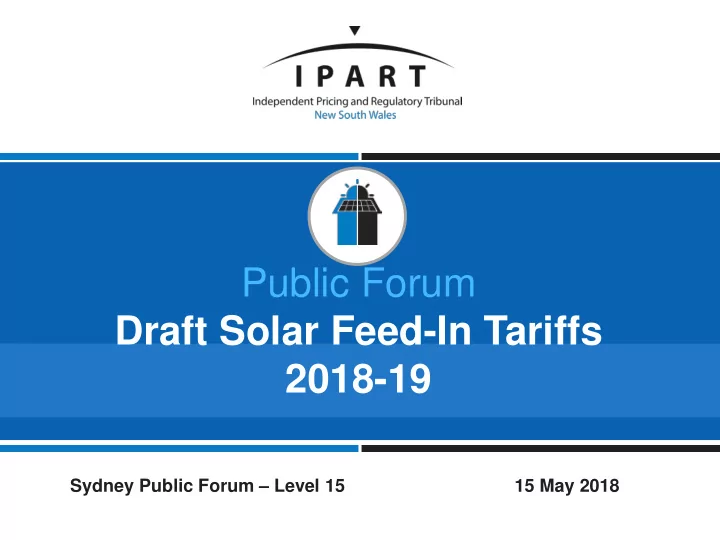

Public Forum Draft Solar Feed-In Tariffs 2018-19 Sydney Public Forum – Level 15 15 May 2018
The NSW Electricity To help guide retailers Government has Retailers can choose and customers, IPART whether or not to offer annually recommends asked us to set solar feed-in tariffs a benchmark benchmarks each year Our draft all-day feed- in benchmark is 7.5 c/kwh
Our benchmarks are based on what retailers would pay to purchase electricity from the NEM But they still have to pay network Retailers avoid cost and green costs on the wholesale costs energy they supply when they supply their customers with solar exports
Our forecast wholesale price is The draft benchmark around $ 78/MWh. is lower than last year mainly due to a lower forecast wholesale price 4
But forecast wholesale prices are still above the medium-term average Our forecast wholesale price is around $ 78/MWh. Medium-term average 5
The draft benchmark is higher than it was in 2015-16 and 2016-17 This year the value of solar exports is about the same as the average wholesale price Our forecast wholesale price is around c/kWh $ 78/MWh. 6
The solar multiplier is a smaller component of our draft benchmark for 2018-19 For 2018-19, the value of solar exports is about The solar multiplier is 14 12.80 the same as the how much higher or average wholesale lowe r the value of 12 solar exports are price compared to the Value of Solar PV Exports, c/kWh average wholesale 10 Our forecast wholesale price price is around 7.50 $ 78/MWh. 8 6.00 6 4 2 0 2016-17 2017-18 (Current) 2018-19 (Forecast) -2 Wholesale Price Solar Multiplier Losses NEM Fees & Charges 7
Wholesale prices are relatively flat for the times that most solar is exported Highest value solar from 5:30 to 6:30pm (less than 1% of solar exports ) Wholesale Price /Solar Exports 91% of exports 05:30 06:30 07:30 08:30 09:30 10:30 11:30 12:30 13:30 14:30 15:30 16:30 17:30 18:30 19:30 20:30 Time 8 2016-17 Wholesale Electricity Prices Average Daily Total Solar Exports (for 500 Customers, mWh)
Prices are no longer spiking in the early afternoon Peak prices are occurring later in the afternoon and evening TIME 9
We have set time-varying benchmarks to provide information about the value of exports throughout the day 10
A higher feed-in tariff would lead to higher bills for all customers Additional Increase in Feed-in Tariff Higher feed-in cost to annual tariffs would c/kWh retailers household bill increase costs for retailers 15 $ 58.6m $ 22 25 $ 136.8m $ 50 30 $ 175.9m $ 65 All customers currently pay around $15 on average to subsidise the upfront cost of solar panels, under the Government’s Small Scale Renewable Energy Scheme 11
A higher feed-in tariff doesn’t necessarily mean a lower bill We have found no correlation between feed-in tariffs and higher or lower bills Usually, the retail price for the electricity you avoid buying (by using your own solar) is most important
The major saving for solar customers is from avoiding electricity purchasing at the retail price
Recommend
More recommend